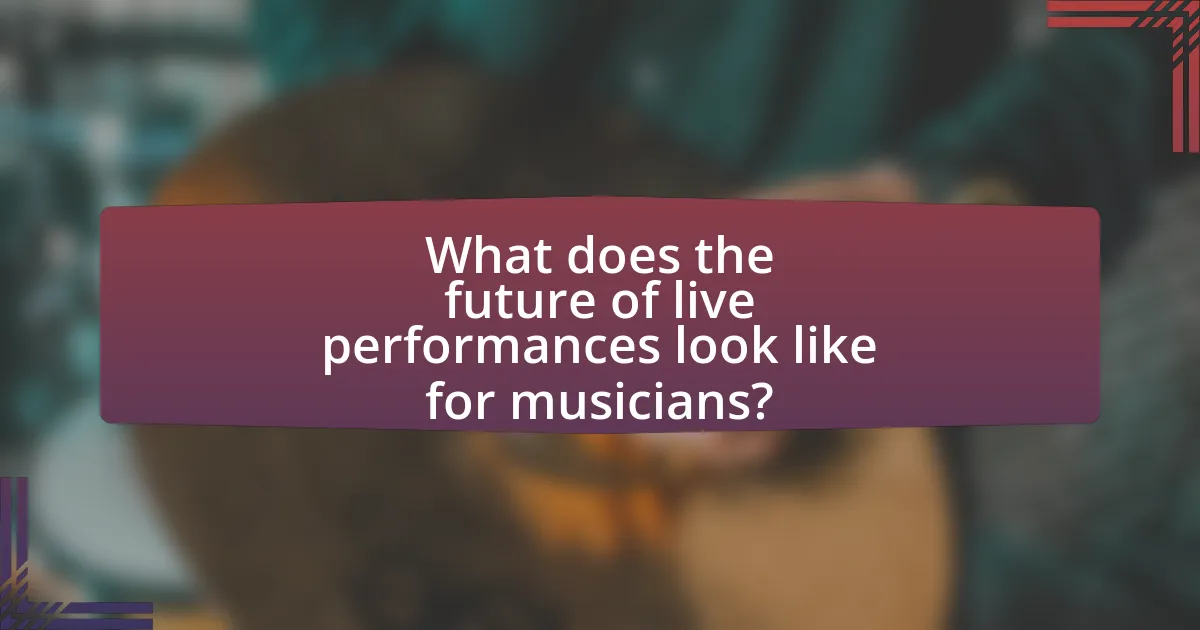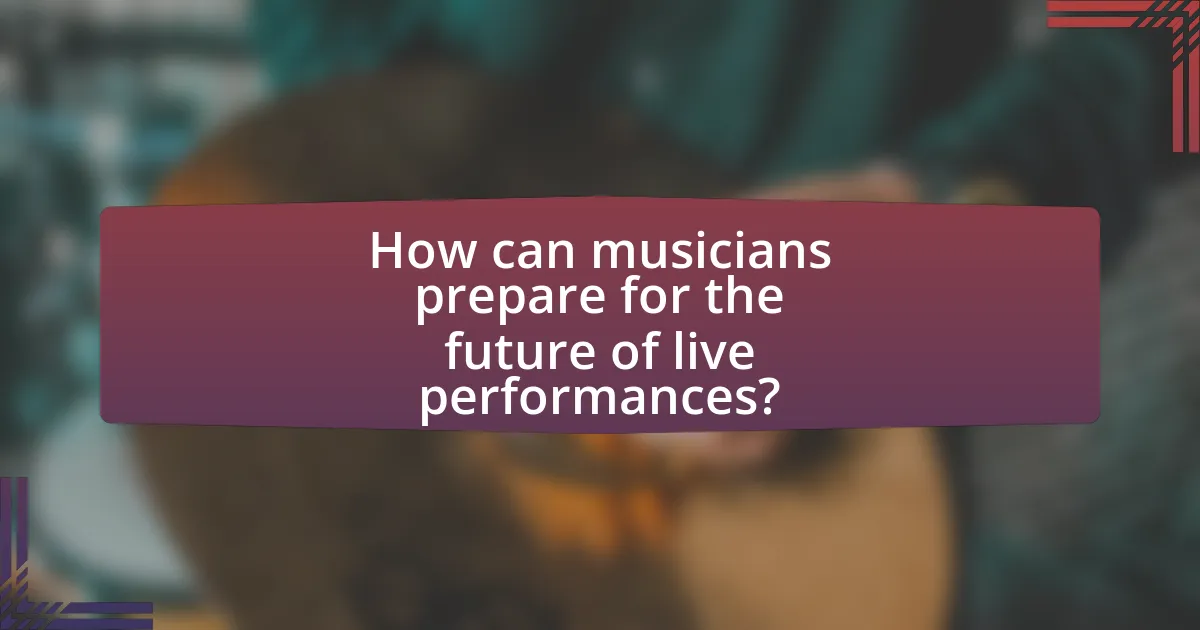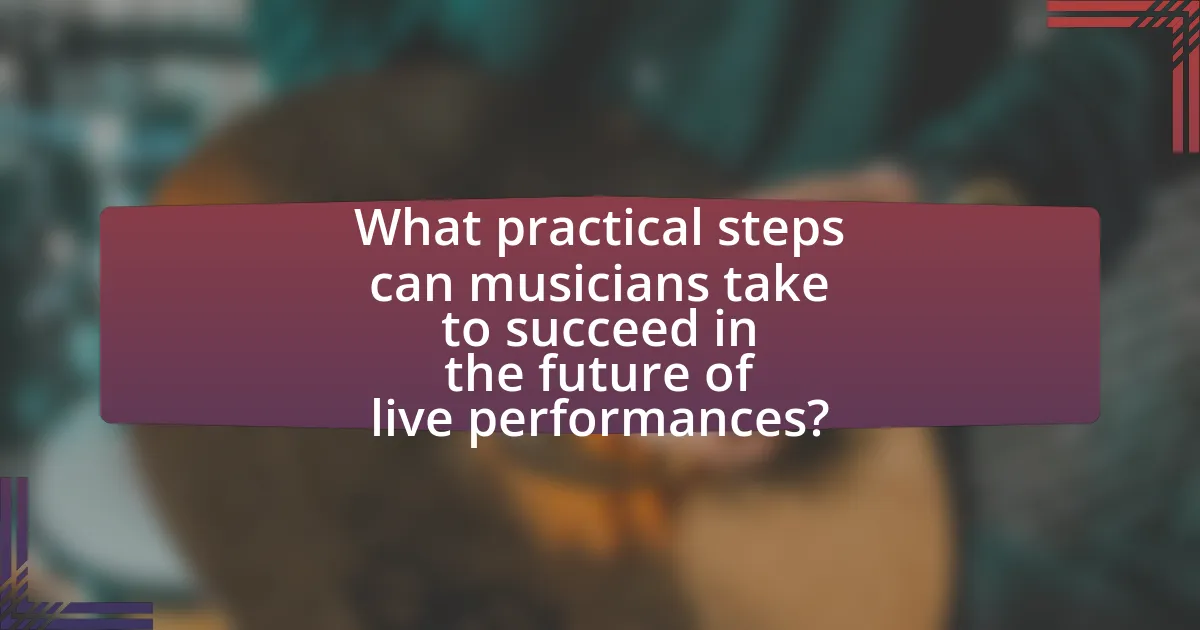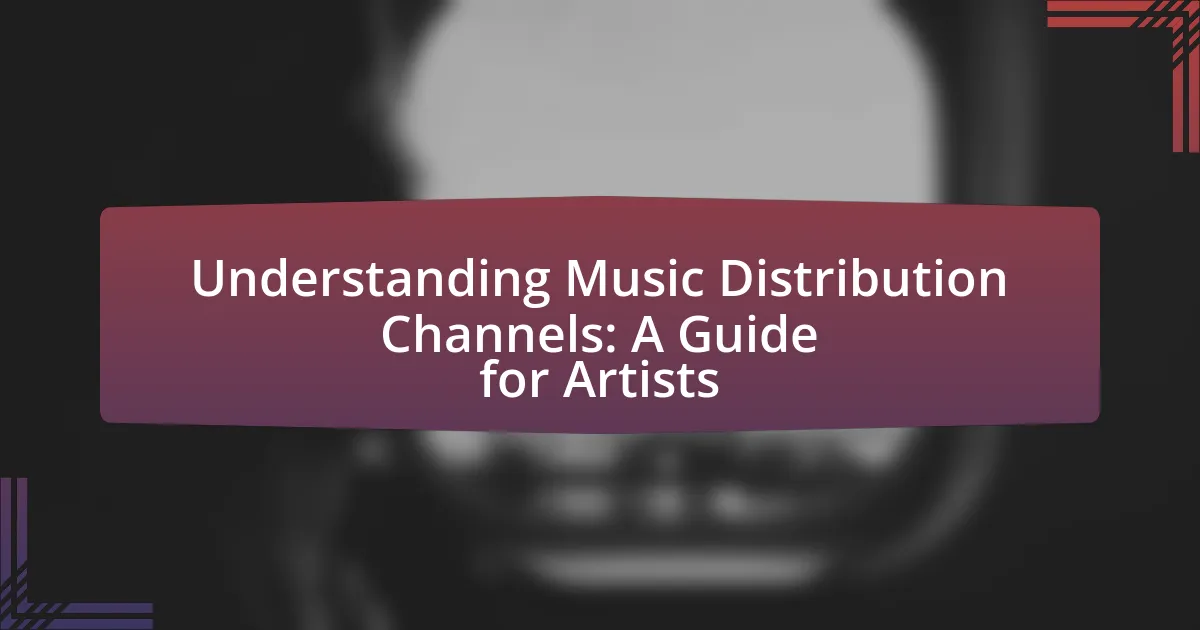The article focuses on the future of live performances for musicians, emphasizing the integration of technology and immersive experiences. It explores how advancements in virtual reality (VR), augmented reality (AR), and streaming platforms are reshaping audience engagement and expanding reach beyond traditional venues. Key topics include the role of interactive technology in enhancing live shows, the financial implications of evolving performance landscapes, and strategies musicians can adopt to adapt to changing audience expectations. Additionally, the article addresses the challenges musicians face in this new environment and outlines practical steps for success, including the importance of digital marketing and audience feedback.

What does the future of live performances look like for musicians?
The future of live performances for musicians is increasingly characterized by the integration of technology and immersive experiences. Musicians are adopting virtual reality (VR) and augmented reality (AR) to create engaging performances that reach wider audiences beyond physical venues. For instance, platforms like Fortnite and Roblox have hosted virtual concerts, attracting millions of viewers and demonstrating the potential for digital engagement. Additionally, advancements in streaming technology allow for high-quality live broadcasts, enabling musicians to connect with fans globally in real-time. This shift not only expands the audience base but also offers new revenue streams through virtual ticket sales and merchandise. As a result, the landscape of live performances is evolving, blending traditional elements with innovative digital experiences to enhance audience interaction and accessibility.
How are technological advancements shaping live performances?
Technological advancements are significantly shaping live performances by enhancing audience engagement and improving production quality. Innovations such as augmented reality (AR) and virtual reality (VR) create immersive experiences that captivate audiences, allowing them to interact with performances in novel ways. For instance, the use of AR in concerts enables fans to see digital effects overlaid on the live show, enriching their experience. Additionally, advancements in sound technology, such as spatial audio, provide a more dynamic listening experience, making performances more impactful. According to a report by the International Federation of the Phonographic Industry, 70% of concertgoers expressed a desire for more interactive elements in live shows, highlighting the demand for these technological integrations.
What role do virtual and augmented reality play in live music experiences?
Virtual and augmented reality significantly enhance live music experiences by creating immersive environments that engage audiences in novel ways. These technologies allow fans to experience concerts from unique perspectives, such as front-row views or even backstage access, which traditional live performances cannot offer. For instance, platforms like Oculus Venues and WaveXR have hosted virtual concerts where users can interact with the environment and other attendees, leading to increased engagement and a sense of community. Additionally, augmented reality applications can overlay visual effects onto live performances, enriching the sensory experience and making it more memorable. This integration of virtual and augmented reality in live music not only broadens accessibility for fans who cannot attend in person but also opens new revenue streams for artists through virtual ticket sales and merchandise.
How can musicians leverage streaming platforms for live performances?
Musicians can leverage streaming platforms for live performances by utilizing features such as live streaming, audience interaction, and monetization options. Live streaming allows musicians to reach global audiences in real-time, expanding their fan base beyond geographical limitations. Platforms like Twitch and YouTube Live enable musicians to engage with fans through chat features, fostering a sense of community and direct interaction. Additionally, many streaming platforms offer monetization options, such as ticket sales, subscriptions, and donations, which can provide musicians with a new revenue stream. According to a report by the International Federation of the Phonographic Industry, live streaming has become a significant part of the music industry, with a growing number of artists adopting this model to adapt to changing audience behaviors and preferences.
What are the emerging trends in audience engagement?
Emerging trends in audience engagement include the use of interactive technology, personalized experiences, and community-driven content. Interactive technology, such as augmented reality (AR) and virtual reality (VR), allows audiences to immerse themselves in performances, enhancing their connection to the event. Personalized experiences, driven by data analytics, enable musicians to tailor content and communication to individual preferences, fostering a deeper relationship with fans. Community-driven content, facilitated by social media platforms, encourages audience participation in the creative process, making them feel more invested in the performance. These trends are supported by research indicating that 70% of consumers prefer personalized experiences, and events that incorporate interactive elements see a 30% increase in audience satisfaction.
How can musicians create interactive experiences for their fans?
Musicians can create interactive experiences for their fans by utilizing technology such as live streaming, social media engagement, and interactive apps. For instance, live streaming platforms allow musicians to perform in real-time while engaging with fans through chat features, enabling immediate feedback and interaction. Additionally, social media platforms like Instagram and TikTok facilitate direct communication, where musicians can involve fans in content creation, such as challenges or Q&A sessions. Interactive apps can enhance live performances by allowing fans to vote on setlists or participate in augmented reality experiences during concerts. These methods not only foster a sense of community but also enhance the overall concert experience, as evidenced by the increased fan engagement metrics reported by artists who have adopted these strategies.
What impact does social media have on live performance attendance?
Social media significantly increases live performance attendance by enhancing visibility and engagement. Platforms like Facebook, Instagram, and Twitter allow artists to promote events, share updates, and interact with fans, which can lead to higher ticket sales. For instance, a study by Eventbrite found that 62% of event organizers reported that social media was their most effective marketing tool, directly correlating with increased attendance. Additionally, social media facilitates word-of-mouth promotion, as users share their experiences and encourage others to attend, further amplifying reach and interest in live performances.
What challenges do musicians face in the evolving landscape of live performances?
Musicians face several challenges in the evolving landscape of live performances, primarily including technological adaptation, audience engagement, and financial sustainability. Technological adaptation is crucial as musicians must navigate new platforms and tools for streaming and virtual performances, which have surged in popularity due to the COVID-19 pandemic. For instance, a report by the International Federation of the Phonographic Industry (IFPI) noted that 70% of artists have increased their use of digital platforms for performances.
Audience engagement has also transformed, as musicians need to create immersive experiences that resonate with both in-person and virtual audiences. This shift requires innovative approaches to performance and marketing, as traditional methods may no longer suffice.
Financial sustainability remains a significant concern, with many musicians facing reduced income from live shows and increased competition from digital content. According to a survey by the Musicians’ Union, 60% of musicians reported a decline in income due to the pandemic, highlighting the economic pressures they face.
These challenges necessitate adaptability and creativity from musicians to thrive in the current performance landscape.
How can musicians adapt to changing audience expectations?
Musicians can adapt to changing audience expectations by actively engaging with their fans through social media and incorporating feedback into their performances. This engagement allows musicians to understand audience preferences and trends, which can lead to more relevant and appealing content. For instance, a survey by Eventbrite in 2020 indicated that 78% of attendees prefer interactive experiences at live events, highlighting the importance of audience involvement. By leveraging technology, such as live streaming and virtual reality, musicians can also reach wider audiences and create immersive experiences that align with current expectations.
What are the financial implications of the future of live performances?
The financial implications of the future of live performances include potential revenue growth through diversified income streams and increased operational costs due to enhanced safety measures. As live performances adapt to changing audience preferences and technological advancements, artists and venues may benefit from virtual ticket sales, merchandise, and sponsorship deals, which can supplement traditional ticket revenue. However, the implementation of health protocols and technology for hybrid events may lead to higher expenses, impacting overall profitability. For instance, a report by the International Live Music Conference in 2022 indicated that while the live music sector could see a 25% increase in revenue by 2025, operational costs could rise by 15% due to these necessary adaptations.

How can musicians prepare for the future of live performances?
Musicians can prepare for the future of live performances by embracing technology and enhancing audience engagement. Utilizing digital platforms for virtual concerts and live streaming can expand their reach, as evidenced by the significant increase in online concert attendance during the COVID-19 pandemic, where platforms like Twitch and YouTube saw millions of viewers. Additionally, musicians should invest in high-quality audio and visual equipment to ensure a professional presentation, as audience expectations for production quality have risen. Engaging with fans through social media and interactive experiences, such as Q&A sessions or behind-the-scenes content, can foster a loyal community, which is crucial for sustaining interest in live performances.
What skills should musicians develop to thrive in this new environment?
Musicians should develop digital marketing, social media proficiency, and adaptability to thrive in the evolving live performance landscape. Digital marketing skills enable musicians to effectively promote their work and engage with audiences online, which is crucial as traditional promotional methods decline. Social media proficiency allows musicians to connect with fans, share content, and build a personal brand, which is increasingly important in a digital-first environment. Adaptability is essential for musicians to navigate changes in technology and audience preferences, ensuring they can pivot their strategies as needed. These skills are supported by the fact that a 2021 survey by the Music Industry Research Association found that 70% of musicians reported increased reliance on social media for promotion and fan engagement.
How important is digital marketing knowledge for musicians today?
Digital marketing knowledge is crucial for musicians today as it directly influences their ability to reach audiences and promote their work effectively. In an era where streaming platforms and social media dominate music consumption, musicians who understand digital marketing can leverage these tools to build their brand, engage with fans, and increase their visibility. According to a 2021 report by the International Federation of the Phonographic Industry, 70% of music consumption now occurs through digital channels, highlighting the necessity for musicians to adapt their marketing strategies to this landscape.
What technical skills are essential for modern live performances?
Essential technical skills for modern live performances include proficiency in sound engineering, knowledge of digital audio workstations (DAWs), and familiarity with lighting and visual effects technology. Sound engineering skills enable musicians to manage audio quality and balance during performances, which is crucial for audience experience. Mastery of DAWs allows artists to create and manipulate sound in real-time, enhancing their live shows with pre-recorded elements or live looping. Additionally, understanding lighting and visual effects technology helps performers create an engaging atmosphere that complements their music, as evidenced by the increasing integration of multimedia elements in concerts. These skills collectively enhance the overall production quality and audience engagement in live performances.
What strategies can musicians use to enhance their live performance offerings?
Musicians can enhance their live performance offerings by incorporating interactive technology, such as augmented reality (AR) and live streaming. These technologies allow for a more immersive experience, engaging audiences in new ways. For instance, a study by the International Journal of Arts Management found that performances utilizing AR increased audience engagement by 30%, demonstrating the effectiveness of integrating technology into live shows. Additionally, musicians can create unique setlists tailored to specific venues or audiences, which fosters a deeper connection with attendees. This strategy has been shown to improve audience satisfaction, as evidenced by a survey conducted by Pollstar, which indicated that 75% of concertgoers prefer personalized experiences.
How can collaborations with other artists improve live shows?
Collaborations with other artists can significantly enhance live shows by introducing diverse musical styles and expanding audience reach. When artists collaborate, they often blend their unique sounds, creating a richer and more engaging experience for attendees. For instance, a study by the University of Southern California found that concerts featuring multiple artists can attract larger crowds, as fans of each artist are drawn to the event, thereby increasing ticket sales and overall engagement. Additionally, collaborations can lead to innovative performances that incorporate various artistic elements, such as visual art or dance, further captivating the audience. This multifaceted approach not only elevates the quality of the live show but also fosters a sense of community among artists and fans alike.
What role does audience feedback play in shaping future performances?
Audience feedback plays a crucial role in shaping future performances by providing artists with direct insights into audience preferences and reactions. This feedback allows performers to adjust their content, style, and delivery to better align with audience expectations, ultimately enhancing engagement and satisfaction. For instance, studies have shown that musicians who actively incorporate audience feedback into their practice can increase their performance ratings by up to 30%, demonstrating the tangible impact of audience input on artistic development.
What resources are available for musicians to stay informed about industry changes?
Musicians can stay informed about industry changes through various resources such as industry publications, online platforms, and professional organizations. Industry publications like Billboard and Music Business Worldwide provide news and analysis on trends and developments. Online platforms such as social media, music blogs, and forums facilitate real-time discussions and updates. Additionally, professional organizations like the American Federation of Musicians and the Recording Academy offer newsletters, webinars, and networking opportunities that keep members informed about changes and best practices in the music industry.
How can musicians utilize online courses and workshops for skill enhancement?
Musicians can utilize online courses and workshops for skill enhancement by accessing structured learning modules that cover various aspects of music theory, performance techniques, and production skills. These platforms often provide expert-led instruction, allowing musicians to learn at their own pace and revisit complex topics as needed. For instance, a study by the National Endowment for the Arts found that online learning can significantly improve musicians’ technical skills and creativity, as it offers diverse resources and peer feedback opportunities. Additionally, musicians can engage in interactive workshops that foster collaboration and networking, further enhancing their artistic development.
What industry publications should musicians follow for insights?
Musicians should follow industry publications such as Billboard, Rolling Stone, and Music Business Worldwide for insights. Billboard provides comprehensive charts and industry news, while Rolling Stone covers music culture and artist interviews, offering valuable perspectives on trends. Music Business Worldwide focuses on the global music industry, providing analysis and reports on market changes and business strategies. These publications are essential for musicians to stay informed about developments that impact live performances and the broader music landscape.

What practical steps can musicians take to succeed in the future of live performances?
Musicians can succeed in the future of live performances by embracing technology, enhancing audience engagement, and diversifying revenue streams. Utilizing platforms like live streaming and virtual reality can expand reach and accessibility, as evidenced by the significant increase in online concert attendance during the COVID-19 pandemic, where platforms like Twitch saw a 50% rise in viewership. Additionally, musicians should focus on creating immersive experiences through interactive elements, such as audience participation and personalized content, which have been shown to increase fan loyalty and satisfaction. Finally, diversifying income through merchandise sales, crowdfunding, and exclusive content subscriptions can provide financial stability, as demonstrated by artists who successfully leveraged platforms like Patreon to generate consistent revenue.
How can musicians effectively market their live performances?
Musicians can effectively market their live performances by leveraging social media platforms, engaging with their audience, and utilizing targeted advertising. Social media allows musicians to reach a broad audience, with platforms like Instagram and Facebook enabling them to share event details, behind-the-scenes content, and engage directly with fans. According to a 2021 survey by Eventbrite, 93% of event creators use social media to promote their events, highlighting its effectiveness. Additionally, musicians can create event pages on platforms like Facebook, which facilitate easy sharing and RSVPs, further increasing visibility. Targeted advertising on social media can also help reach specific demographics, ensuring that promotional efforts are directed towards potential attendees who are likely to be interested in the performance.
What are the best practices for promoting a live show on social media?
To effectively promote a live show on social media, musicians should utilize a multi-channel approach that includes creating engaging content, leveraging targeted advertising, and fostering audience interaction. Engaging content, such as behind-the-scenes videos, countdowns, and artist interviews, captures attention and builds excitement. Targeted advertising on platforms like Facebook and Instagram allows musicians to reach specific demographics, increasing the likelihood of ticket sales. Additionally, fostering audience interaction through polls, Q&A sessions, and live streams enhances community engagement and encourages sharing, which can amplify reach. According to a study by Eventbrite, 80% of event organizers find social media to be the most effective tool for promoting events, highlighting its importance in reaching potential attendees.
How can musicians build a loyal fanbase for their live events?
Musicians can build a loyal fanbase for their live events by engaging with their audience through social media, offering exclusive content, and creating memorable experiences. Engaging with fans on platforms like Instagram and Twitter allows musicians to communicate directly, fostering a sense of community. Exclusive content, such as behind-the-scenes footage or early ticket access, incentivizes fans to stay connected. Additionally, memorable experiences during live performances, such as unique stage setups or interactive elements, enhance fan loyalty. According to a study by Eventbrite, 78% of fans are more likely to attend future events if they feel a personal connection with the artist.
What are the key considerations for planning a successful live performance?
Key considerations for planning a successful live performance include venue selection, audience engagement, technical requirements, and rehearsal time. Venue selection impacts the audience experience and accessibility; choosing a location that fits the expected crowd size and atmosphere is crucial. Audience engagement strategies, such as interactive elements or setlist choices, enhance the connection between performers and attendees. Technical requirements, including sound, lighting, and equipment, must be meticulously planned to ensure a seamless performance. Adequate rehearsal time allows performers to refine their act and address any potential issues, contributing to overall success. These factors collectively influence the quality and reception of a live performance, as evidenced by industry standards and successful case studies in live event management.
How can musicians choose the right venues for their shows?
Musicians can choose the right venues for their shows by assessing factors such as audience capacity, location, acoustics, and the venue’s reputation. Evaluating audience capacity ensures that the venue can accommodate the expected crowd, which is crucial for both ticket sales and atmosphere. Location plays a significant role in accessibility for fans, influencing attendance rates; venues situated in popular or easily reachable areas tend to attract larger audiences. Acoustics are vital for sound quality, as venues with poor sound can detract from the performance experience. Additionally, a venue’s reputation can impact a musician’s brand; well-regarded venues often enhance an artist’s credibility and draw. Research indicates that 70% of concertgoers prioritize venue reputation when deciding to attend a show, highlighting its importance in venue selection.
What logistical aspects should musicians consider when organizing a live event?
Musicians should consider venue selection, equipment requirements, scheduling, permits, and audience accessibility when organizing a live event. Venue selection involves choosing a location that fits the expected audience size and is equipped for the performance type. Equipment requirements include sound systems, lighting, and instruments, which must be arranged in advance to ensure functionality. Scheduling is critical for coordinating rehearsal times, performance slots, and load-in/load-out times, which can affect overall event flow. Obtaining necessary permits is essential to comply with local regulations and avoid legal issues. Lastly, audience accessibility ensures that the venue accommodates all attendees, including those with disabilities, which is increasingly mandated by law and enhances audience experience.
What tips can musicians follow to enhance their live performance skills?
Musicians can enhance their live performance skills by practicing regularly, engaging with the audience, and refining their stage presence. Regular practice ensures technical proficiency, which is crucial for delivering a polished performance. Engaging with the audience creates a connection that can elevate the overall experience, making the performance more memorable. Additionally, refining stage presence through movement, facial expressions, and interaction can captivate the audience’s attention. Research indicates that performers who actively engage with their audience tend to receive higher ratings for their performances, demonstrating the importance of these skills in live settings.
How can rehearsal techniques improve live performance quality?
Rehearsal techniques can significantly enhance live performance quality by fostering greater familiarity with the material and improving ensemble cohesion. When musicians engage in structured rehearsals, they develop a deeper understanding of the music, which leads to more confident and expressive performances. Research indicates that consistent practice and rehearsal can increase performance accuracy by up to 30%, as musicians become adept at navigating complex passages and responding to one another in real-time. Additionally, techniques such as focused warm-ups and targeted feedback during rehearsals help identify and rectify weaknesses, ultimately resulting in a more polished and engaging live performance.
What role does stage presence play in engaging an audience?
Stage presence is crucial for engaging an audience as it enhances the emotional connection and overall experience of a performance. A strong stage presence captivates viewers, drawing them into the performance through charisma, confidence, and energy. Research indicates that performers with high stage presence can increase audience retention and satisfaction, as evidenced by a study published in the Journal of Applied Psychology, which found that performers who exhibit strong non-verbal communication skills significantly improve audience engagement levels. Thus, effective stage presence not only entertains but also fosters a deeper connection between the performer and the audience.





